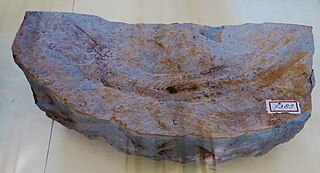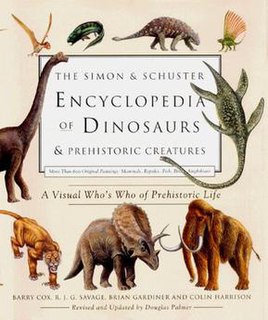
Diapsids are a group of amniote tetrapods that developed two holes in each side of their skulls about 300 million years ago during the late Carboniferous period. The diapsids are extremely diverse, and include all crocodilians, lizards, snakes, tuatara, turtles, and birds. Although some diapsids have lost either one hole (lizards), or both holes, or have a heavily restructured skull, they are still classified as diapsids based on their ancestry. At least 17,084 species of diapsid animals are extant: 9,159 birds, and 7,925 snakes, lizards, tuatara, turtles, and crocodiles.

Platybelodon was a genus of large herbivorous mammals related to the elephant. It lived during the middle Miocene Epoch in Africa, Asia and the Caucasus.

Eureptilia is one of the two major subgroups of the clade Sauropsida, the other one being Parareptilia. Eureptilia includes Diapsida, as well as a number of primitive Permo-Carboniferous forms previously classified under Anapsida, in the old order "Cotylosauria".

John Desmond Clark was a British archaeologist noted particularly for his work on prehistoric Africa.

Ophiderpeton is an extinct genus of aistopod tetrapodomorphs from the early Carboniferous to the early Permian. Remains of this genus are widespread and were found in Ohio, United States, Ireland, and the Czech Republic.

The red-bellied short-necked turtle, pink-bellied side-necked turtle, or Jardine River turtle is a species of turtle in the family Chelidae.
Based on archeological finds, Brooman Point Village is an abandoned village in Qikiqtaaluk Region, Nunavut, Canada. It is located in the central High Arctic on a point of the Gregory Peninsula, part of the eastern coast of Bathurst Island. Brooman was both a Late Dorset culture Paleo-Eskimo village as well as an Early Thule culture village. Both the artifacts and the architecture, specifically longhouses, are considered important historical remains of the two cultures. The site shows traces of Palaeo-Eskimo occupations between about 2000 BC and 1 AD, but the major prehistoric settlement occurred from about 900 to 1200 AD.
Powichthys is a genus of prehistoric lobe-finned fish which lived during the Devonian period. This fish it was small in size, about 30 cm. Prior to the discovery of P. spitsbergensis in 2004, the genus was known from a single type species, P. thorsteinssoni.
Ferganoceratodus is a genus of prehistoric lungfish which lived during the Jurassic and Cretaceous periods. It is a basal member of the suborder Ceratodontoidei. Despite only being known from Mesozoic-aged rocks, phylogenetic analyses indicate that it diverged from the rest of the suborder during the late Carboniferous.

Dutuitosaurus is a genus of metoposaurids, a group of amphibians that lived during the Late Triassic period. Dutuitosaurus was discovered in the early 1960s in Morocco and is known from the lower t5 units of the Timezgadiouine Formation exposures in the Argana Basin of the High Atlas Mountains and was first described in 1976 by French paleontologist Jean-Michel Dutuit. Material of Dutuitosaurus is currently held in the Muséum national d'histoire naturelle (MNHN) in Paris, France. It was originally placed within Metoposaurus as M. ouazzoui but was subsequently placed in its own genus, Dutuitosaurus, by Hunt (1993), who identified a number of differences between Metoposaurus and the Moroccan metoposaurids. Features that differentiate Dutuitosaurus from other metoposaurids include relative elongate intercentra and a maxilla that enters the orbit.

Echidnocephalus troscheli is an extinct, prehistoric halosaur. Fossils are found from Campanian strata of Westphalia, Germany. The complete and incomplete fossil specimens that have been found suggest an animal already looking very much like modern halosaurs.
Mioceratodus is an extinct genus of lungfish in the family Neoceratodontidae, which also contains the extant Queensland lungfish. It is known only from Oligocene and Miocene-aged sediments in Australia, although phylogenetic evidence supports it having first diverged from its closest relative, Neoceratodus, during the Late Jurassic or Early Cretaceous period.

Paraceratodus is an extinct genus of prehistoric lungfish. Only one species, P. germaini, is known from the latest Permian or earliest Triassic period of Madagascar. Phylogenetic evidence supports it being the most basal member of the suborder Ceratodontoidei, which contains modern lungfish, and as with the rest of the order it likely diverged during the late Carboniferous.
Acentrophorus is an extinct genus of prehistoric ray-finned fish from the Permian and Triassic periods. Fossils have been found in Australia, Germany and the United Kingdom. It was the oldest known neopterygian.

The Simon & Schuster Encyclopedia of Dinosaurs and Prehistoric Creatures: A Visual Who's Who of Prehistoric Life is an encyclopedia that was published in 1999 by Simon & Schuster. The book was first published in 1988.

The Trionychinae are a subfamily of turtles in the family Trionychidae.
Ustatochoerus is an extinct genus of oreodont of the family Merycoidodontidae, endemic to North America. It lived during the late Oligocene to Miocene, 24–10.3 mya, existing for approximately 14 mya. Fossils are widespread through the central and western United States.
Choerolophodon is an extinct genus of proboscid which lived during the Miocene of Eurasia and Africa.
The Paracenoceratidae are an extinct family of prehistoric nautiloids. The cephalopods lived during the Jurassic and Cretaceous periods.

Eomellivora is an extinct genus of prehistoric mustelids, closely related to the honey badger, known from Eurasia and North America, and tentatively Africa.












